Complete Solutions to EXAMPLE of chapter MODEL PAPER 3 of Class 9 book with complete answers and questions
| Class 9 | MATHS |
| Chapter | MODEL PAPER 3 |
| MAXIMUM PUBLICATION | EXAMPLE |
| Number Of Questions | 61 |
| Academic Year | 2023-24 |
In triangle ABC,AD is the blsector of `/_A`,`AB=10` cm,`AC=5` cm.
What is `BD:CD` ?
 03:25View Solution
03:25View SolutionIn triangle ABC,AD is the bisector of `/_A`,`AB=10` cm,`AC=5` cm. If `BD=4`cm,find CD.
02:50View SolutionWhat `1/2+1/2^2` in the form `A/B`.What is the decimal form of `1/2+1/2^2` ?
02:42View SolutionThe sides of a triangle are 8cm,10cm and 6cm.
What kind of triangle is this?03:14View SolutionThe sides of a triangle are 8cm,10cm and 6cm.
What is the radius of the circumcircle?04:48View Solution`/_\ABC` is an equilateral triangle of side 2cm. What is the altitude from A to BC? What is the perimeter of the square drawn with altitude as the side?
03:45View SolutionDivide a line of length 7cm in the ratio `3:2`
03:57View SolutionWrite `1/3` in the decimal form as `0.333…….`
01:39View SolutionSum of the digit of a two digit number is 5. Digit in the right end is 1 less than the digit in the left end.
If the digit in the right end is x and that in the left end is y, Write the pair of equations.04:26View SolutionSum of the digit of a two digit number is 5. Digit in the right end is 1 less than the digit in the left end.
Find the number by solving the equations.03:44View SolutionThe length of a rectangle is `sqrt2`cm and the breadth `1/sqrt2` cm.
What is the approximate sum of length and breadth.04:51View SolutionThe length of a rectangle is `sqrt2`cm and the breadth `1/sqrt2` cm.
Calculate the approximate perimeter of the rectangle.02:16View SolutionIn the figure,AD is the line joining a vertex to the mid point of the opposite side.
G is a point on AD which divides AD in the ratio `2:1` as `AG:GD=2:1`
The area of `/_\BGA` is 24 `cm^2`.What is the area of `/_\BGD`?
 04:28View Solution
04:28View SolutionIn the figure,AD is the line joining a vertex to the mid point of the opposite side.
G is a point on AD which divides AD in the ratio `2:1` as `AG:GD=2:1`
What is the area of triangle BGC.
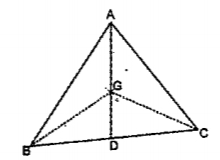 05:30View Solution
05:30View SolutionIn the figure,AD is the line joining a vertex to the mid point of the opposite side.
G is a point on AD which divides AD in the ratio `2:1` as `AG:GD=2:1`
Name the triangle having equal area in the picture
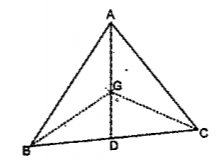 04:35View Solution
04:35View Solution`x=sqrt(0.444…)`
What is the fractional form of `x^2`01:21View Solution`x=sqrt(0.444…)`
What is the fractional form of x03:05View Solution`x=sqrt(0.444…)`
Find `x+1/x`01:45View SolutionThe difference between the sides of two squares is 2. The difference between their area is `33cm^2`. Find the sides.
03:02View SolutionIn `/_\ABC`, `AB=4cm`,`AC=5cm`,`/_A=120°`.
Draw the triangle and construct its circumcicle. What is the radius of the circumcircle.02:39View SolutionIn the figure `/_A=90°`,`/_B=60°`
`BC=10cm`
What is the length of the side AB
 02:49View Solution
02:49View SolutionComplete the table
 03:32View Solution
03:32View SolutionIn the figure `/_A=90°`,`/_B=60°`
`BC=10cm`
Calculate the area of this triangle.
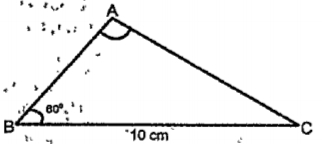 04:11View Solution
04:11View SolutionCost of 2 pens and 3 pencils is 70 rupees. Cost of 2 pens and 5 pencils is 90 rupees
What is the cost of one pencil?02:40View SolutionCost of 2 pens and 3 pencils is 70 rupees. Cost of 2 pens and 5 pencils is 90 rupees
What is the cost of one pen03:18View SolutionCost of 2 pens and 3 pencils is 70 rupees. Cost of 2 pens and 5 pencils is 90 rupees
What is the cost of 10pens and 10 pencils03:58View SolutionCost of 2 pens and 3 pencils is 70 rupees. Cost of 2 pens and 5 pencils is 90 rupees
What is the cost of 3pens and 2pencils together.04:30View SolutionIn `/_\ABC`,AQ is the bisector of `/_A`.`AB=18`,`AC=12`,`AQ=6` If AP is the bisector of `/_BAQ` What is `BQ:QC`?
03:02View SolutionIn `/_\ABC`,AQ is the bisector of `/_A`. `AB=18`,`AC=12`,`AQ=6`If AP is the bisector of `/_BAQ` What is `BP:PQ`?
02:55View SolutionIn `/_\ABC`,AQ is the bisector of `/_A`. `AB=18`,`AC=12`,`AQ=6` If AP is the bisector of `/_BAQ` If `BC=16`,find BP,PQ and QC
08:20View SolutionIn `/_\ABC`,AQ is the bisector of `/_A`.
`AB=18`,`AC=12`,`AQ=6`
If AP is the bisector of `/_BAQ`
If the area of `/_\ABP` is A, What is the area of `/_\ABC`.
 05:59View Solution
05:59View SolutionFind the decimal form of `1/11`. Also write `2/11` and `3/11` in the decimal form.
02:10View SolutionTwo years ago Salim's age is three times his daughter's age. After 6years,Salim's age will be 4 more than twice his daughter's age. Calculate the age of Salim and his daughter.
05:37View Solution`x=1/(sqrt2+1)`
What is the approximate value of `1/x(sqrt2=1.414)`01:30View Solution`x=1/(sqrt2+1)`
Find `x+1/x`03:34View Solution`x=1/(sqrt2+1)`
Calculate `(x+1/x)^2`05:24View SolutionIn the figure `BC=4cm` , `/_B=60°`
, `/_C =75°`
Calculate the perimeter of `/_\ABC`
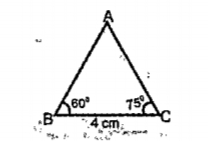 05:31View Solution
05:31View SolutionABCD is square. P,Q,R,S are the mid points of the sides. If side of ABCD is 6cm. What is the length of one side of PQRS.
04:33View SolutionABCD is square. P,Q,R,S are the mid points of the sides. If side of ABCD is 6cm. What is the area of PQRS
03:45View SolutionABCD is square. P,Q,R,S are the mid points of the sides. If side of ABCD is 6cm. Calculate the perimeter of PQRS.
03:30View SolutionIn the quadrilateral ABCD,`AB=5.5`cm,`BC=6.5`cm.
`CD=7` cm `AD=7.5`cm,
`/_A=80°`
Draw a quadrilateral ABCD with these measurement04:27View SolutionThe ratio of incomes of two persons is `9:7` the ratio of their expenses is `4:3`. If each of them saves Rs. 200 every month,find their monthly incomes.
07:52View SolutionA,B,C are three points
`AB=sqrt75`,`BC=sqrt108`
`AC=sqrt363`.
Write these lengths as the product of `sqrt3` and as integer.03:49View SolutionA,B,C are three points
`AB=sqrt75`,`BC=sqrt108`
`AC=sqrt363`.
Check whether these points are on a line or not.03:13View SolutionA,B,C are three points
`AB=sqrt75`,`BC=sqrt108`
`AC=sqrt363`.
What is the approximate distance between A and C.01:30View SolutionIn the picture ABCD is a quadrilateral, AB is parallel to CD. Also `AB=12cm` and radius of the circle 10cm.
What is the distance from center to AB.
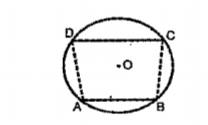 02:34View Solution
02:34View SolutionIn the picture ABCD is a quadrilateral, AB is parallel to CD. Also `AB=12cm` and radius of the circle 10cm.
If the distance from AB and CD is 14cm,What is the length of CD.
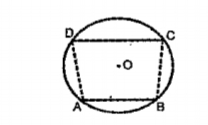 02:38View Solution
02:38View SolutionIn the figure the diagonals AC and BD intersect at P. The area of PAB is `30 cm^2` , area of PDA is `60 cm^2` and area of PBC is `40 cm^2`.
What is `PD:PB`?
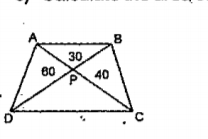 03:51View Solution
03:51View SolutionIn the figure the diagonals AC and BD intersect at P. The area of PAB is `30 cm^2` , area of PDA is `60 cm^2` and area of PBC is `40 cm^2`.
What is the area of PDC
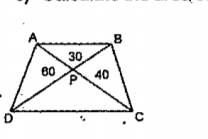 05:00View Solution
05:00View SolutionIn the figure the diagonals AC and BD intersect at P. The area of PAB is `30 cm^2` , area of PDA is `60 cm^2` and area of PBC is `40 cm^2`.
What is `PA:PC`?
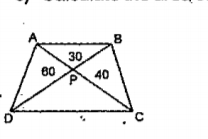 03:15View Solution
03:15View SolutionThe sum of 4 times x and 3 times y is 39. The difference of 3 times x and 2 times y is 8.
Write the pair of equations.01:32View SolutionThe sum of 4 times x and 3 times y is 39. The difference of 3 times x and 2 times y is 8.
Find the numbers by solving the equations.03:35View SolutionABC is an equilateral triangle with side 10 cm, and AD is the altitude to the side BC.
If it cut into two triangles along AD and pieces are joined to get another triangle PQR
What is the length of PS?
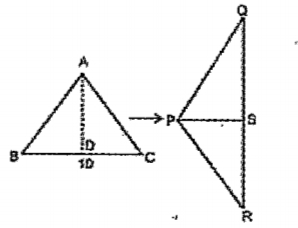 05:01View Solution
05:01View SolutionABC is an equilateral triangle with side 10 cm, and AD is the altitude to the side BC.
If it cut into two triangles along AD and pieces are joined to get another triangle PQR
What is the length of QR?
 03:40View Solution
03:40View SolutionABC is an equilateral triangle with side 10 cm, and AD is the altitude to the side BC.
If it cut into two triangles along AD and pieces are joined to get another triangle PQR
Find the approximate perimeter of `/_\PQR`.
 04:01View Solution
04:01View SolutionABC is an equilateral triangle with side 10 cm, and AD is the altitude to the side BC.
If it cut into two triangles along AD and pieces are joined to get another triangle PQR
Calculate the area of `/_\PQR`.
 04:59View Solution
04:59View SolutionRead the following and answer the questions given below.
1,2,3,4….are natural numbers or counting numbers.
The sum of first 4 numbers is
`1+2+3+4=(1+4)+(2+3)`
`= 5+5`
`= 5xx2`
`=(4+1)+4/2`
We can make pairs as given above and can establish a formula to find the sum of first n natural numbers as sum = `(1+n)xxn/2`
Find the sum of first 10 natural numbers.01:35View SolutionRead the following and answer the questions given below.
1,2,3,4….are natural numbers or counting numbers.
The sum of first 4 numbers is
`1+2+3+4=(1+4)+(2+3)`
`= 5+5`
`= 5xx2`
`=(4+1)+4/2`
We can make pairs as given above and can establish a formula to find the sum of first n natural numbers as sum = `(1+n)xxn/2`
Calculate the sum of natural numbers from 10 to 20.02:41View SolutionRead the following and answer the questions given below.
1,2,3,4….are natural numbers or counting numbers.
The sum of first 4 numbers is
`1+2+3+4=(1+4)+(2+3)`
`= 5+5`
`= 5xx2`
`=(4+1)+4/2`
We can make pairs as given above and can establish a formula to find the sum of first n natural numbers as sum = `(1+n)xxn/2`
In the arrangement of numbers
1,3,6,10,15...
`1=1`,`3=1+2`,`6=1+2+3..`
What is `10^th` number in the arrangement 1,3,6,10,15....04:10View SolutionRead the following and answer the questions given below.
1,2,3,4….are natural numbers or counting numbers.
The sum of first 4 numbers is
`1+2+3+4=(1+4)+(2+3)`
`= 5+5`
`= 5xx2`
`=(4+1)+4/2`
We can make pairs as given above and can establish a formula to find the sum of first n natural numbers as sum = `(1+n)xxn/2`
What is the number at the right and of `10^th` line
1
2 3
4 5 6
7 8 9 10
.............07:54View SolutionRead the following and answer the questions given below.
1,2,3,4….are natural numbers or counting numbers.
The sum of first 4 numbers is
`1+2+3+4=(1+4)+(2+3)`
`= 5+5`
`= 5xx2`
`=(4+1)+4/2`
We can make pairs as given above and can establish a formula to find the sum of first n natural numbers as sum = `(1+n)xxn/2`
Find the sum of first 10 natural numbers.01:35View Solution
EXAMPLE questions and complete solutions for chapter MODEL PAPER 3 of MAXIMUM PUBLICATION of Class 9
